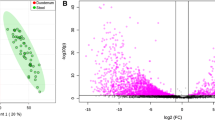Abstract
Segmented, filamentous prokaryotic microorganisms colonize and attach to the cells in the epithelium of the mucosa of the small bowels of mice and rats. Scanning electron micrographs, derived from specimens of mouse small intestine, reveal microbial filaments of at least two types. One type is thin (0.8μm) with only faint lines suggesting septa; the other is thicker (1.4μm) and has distinct segments with pronounced septa. Most of the segments are rounded; a few are thin and elongated. Immediately surrounding the attachment site of these organisms, the surface of the epithelial cells appears roughened and occasionally stringy. The filaments may differ morphologically because they represent different phases in the life cycle of a single microbial type. Alternatively, however, they may differ because they are the cells of different microbial types colonizing the same epithelial habitat.
Similar content being viewed by others
References
Chase, D.G., and S. L. Erlandsen: Evidence for a complex life cycle and endospore formation in the attached, filamentous, segmented bacterium from murine ileum. J. Bacteriol.127, 572–583 (1976)
Davis, C. P., and D. C. Savage: Habitat, succession, attachment, and morphology of segmented, filamentous microbes indigenous to the murine gastrointestinal tract. Infect. Immunol.10, 948–956 (1974)
Davis, C. P., and D. C. Savage: Effect of penicillin on the succession, attachment, and morphology of segmented, filamentous microbes in the murine small bowel. Infect. Immunol.13, 180–188 (1976)
Erlandsen, S. L., and D. G. Chase: Morphological alterations in the microvillus border of villus epithelial cells produced by intestinal microorganisms. J. Clin. Nutr.27, 1277–1286 (1974)
Fuller, R., and A. Turvey: Bacteria associated with the intestinal wall of the fowl. J. Appl. Bacteriol.34, 617–622 (1971)
Hampton, J. C., and B. Rosario: The attachment of microorganisms to epithelial cells in the distal ileum of the mouse. Lab. Invest.14, 1464–1481 (1965)
Malick, L. E., and R. B. Wilson: Evaluation of a modified technique for SEM examination of vertebrate specimens without evaporated metal layers. IIT Res. Inst., Scanning Electron Microscopy,1975, 259–266 (1975)
Savage, D. C.: Localization of certain indigenous microorganisms on the ileal villi of rats. J. Bacteriol.97, 1505–1506 (1969)
Savage, D. C.: Associations and physiological interactions of indigenous microorganisms and gastrointestinal epithelia. Am. J. Clin. Nutr.25, 1372–1379 (1972)
Savage, D. C. and R. Blumershine: Surface-surface associations in microbial communities populating epithelial habitats in the murine gastrointestinal ecosystem: Scanning electron microscopy. Infect. Immunol.10, 240–250 (1974)
Author information
Authors and Affiliations
Rights and permissions
About this article
Cite this article
Blumershine, R.V., Savage, D.C. Filamentous microbes indigenous to the murine small bowel: A scanning electron microscopic study of their morphology and attachment to the epithelium. Microb Ecol 4, 95–103 (1977). https://doi.org/10.1007/BF02014280
Issue Date:
DOI: https://doi.org/10.1007/BF02014280




